Physical Address
304 North Cardinal St.
Dorchester Center, MA 02124
Intraoperative consultation (i.e., frozen section) in salivary gland pathology presents unique diagnostic challenges.
Majority of salivary gland neoplasms (approximately 80%) originate in parotid and submandibular glands:
Approximately 20% to 25% of neoplasms occurring in major salivary glands are malignant.
In parotid gland, most neoplasms arise in superficial lobe
Majority of minor salivary gland neoplasms originate in the oral cavity:
50% to 60% or greater of minor salivary gland tumors are malignant.
Although any type of salivary gland neoplasm may occur in major and minor salivary glands, a number of salivary gland neoplasms predilect to major glands or to minor glands, including:
Predilection to major glands:
Warthin tumor (parotid gland)
Basal cell adenoma (parotid gland)
Oncocytoma (parotid gland)
Acinic cell carcinoma (parotid gland)
Mammary analogue secretory carcinoma (parotid gland)
Basal cell adenocarcinoma (parotid gland)
Epithelial-myoepithelial carcinoma (parotid gland)
Carcinoma ex pleomorphic adenoma (parotid gland)
Salivary duct carcinoma (parotid gland)
Oncocytic carcinoma (parotid gland)
Others
Predilection to minor glands:
Canalicular adenoma (lip)
Cystadenoma (oral cavity)
Polymorphous low-grade adenocarcinoma (palate)
Clear cell carcinomas (oral)
Cribriform adenocarcinoma of minor salivary glands (base of tongue, oral)
Major and minor salivary gland neoplasms share similar morphologic features but contrast in other ways that must be considered in their frozen section evaluation:
Majority of major salivary gland neoplasms are encapsulated, in part or completely:
Major salivary gland benign neoplasms are circumscribed to encapsulated, lacking invasive growth and cytomorphologic features of malignancy:
Some benign neoplasms may be multinodular with nodules separate from one another (e.g., pleomorphic adenoma, basal cell adenoma, canalicular adenoma, Warthin tumor).
Some benign neoplasms may include foci within soft tissues, in particular recurrent pleomorphic adenomas.
Major salivary gland malignant neoplasms show cytomorphologic features of malignancy and/or invasive growth:
Cytomorphologically bland-appearing neoplasms may be malignant on the basis of infiltrative growth:
Examples include adenoid cystic carcinoma, basal cell adenocarcinoma, epithelial-myoepithelial carcinoma, others.
Noninvasive neoplasms may be malignant on the basis of identifying specific cell types or the presence of anaplastic cellular features:
Examples of neoplasms with specific cell types diagnostic for malignancy include mucoepidermoid carcinoma, acinic cell carcinoma, others.
Examples of neoplasms with anaplastic cellular features diagnostic for malignancy include all salivary gland neoplasms composed of histologically high-grade cytomorphology, including salivary duct carcinoma, high-grade carcinoma ex pleomorphic adenoma, high-grade adenocarcinoma, not otherwise specified and high-grade transformation (“dedifferentiation”) of lower grade salivary gland neoplasms.
All minor salivary gland neoplasms are unencapsulated:
Benign minor salivary gland neoplasms are circumscribed without invasive growth.
Benign minor salivary gland neoplasms may be multinodular with nodules separate from one another (e.g., pleomorphic adenoma, basal cell adenoma, canalicular adenoma).
Some benign neoplasms may include foci within soft tissues, in particular recurrent pleomorphic adenomas.
Minor salivary gland malignant neoplasms show cytomorphologic features of malignancy and/or invasive growth.
Cytomorphologically bland-appearing neoplasms may be malignant on the basis of infiltrative growth:
Examples include adenoid cystic carcinoma, polymorphous low-grade adenocarcinoma, clear cell carcinomas, others.
Noninvasive neoplasms may be malignant on the basis of identifying specific cell types or the presence of anaplastic cellular features:
Examples of neoplasms with specific cell types diagnostic for malignancy include mucoepidermoid carcinoma, others.
Examples of neoplasms with anaplastic cellular features diagnostic for malignancy include all salivary gland neoplasms composed of histologically high-grade cytomorphology, including salivary duct carcinoma; high-grade carcinoma ex pleomorphic adenoma; high-grade adenocarcinoma, not otherwise specified and high-grade transformation (“dedifferentiation”) of lower grade salivary gland neoplasms.
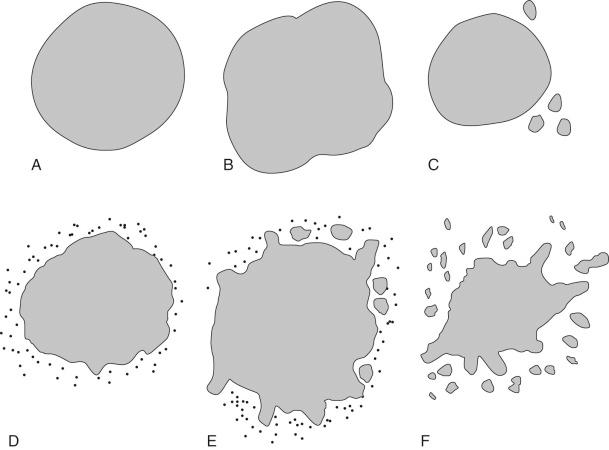
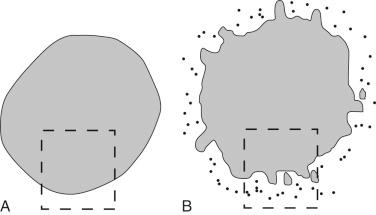

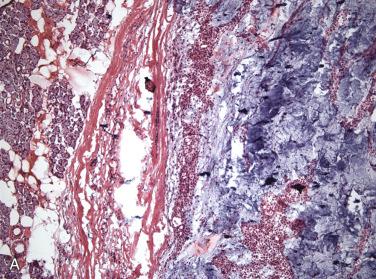
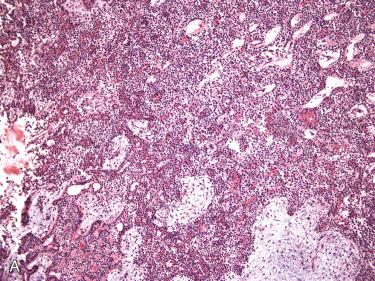
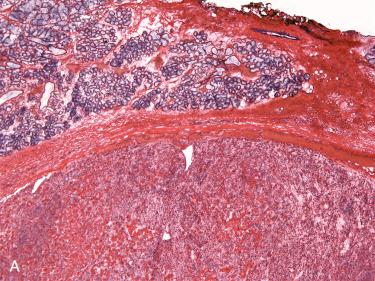
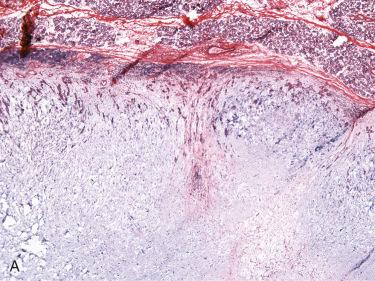
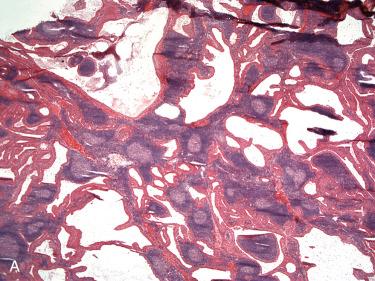
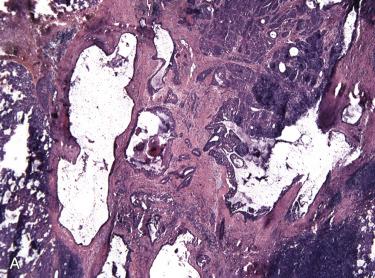
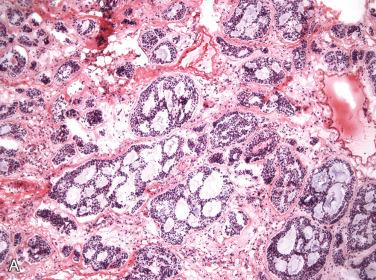
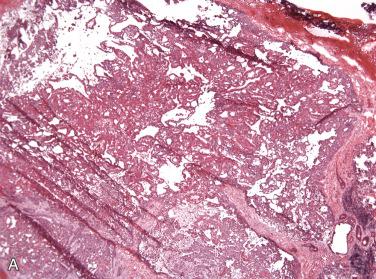

Indications for intraoperative consultation in major salivary gland neoplasms include:
To render a diagnosis (determine tumor type), which may include:
Cases in which there has been an equivocal or inconclusive diagnosis by fine-needle aspiration biopsy (FNAB) or core biopsy
Cases in which a prior diagnostic procedure (e.g., FNAB, biopsy) has not been attempted
To evaluate surgical margins of resection for adequacy of resection:
May include measuring distance between tumor and surgical margin(s)
To determine if lymph node metastases are present:
Identification of nodal metastasis may result in more extensive neck dissection.
High-grade malignant salivary gland neoplasms have increased incidence of nodal metastasis at presentation, including:
High-grade mucoepidermoid carcinoma, salivary duct carcinoma, others
To obtain tissue for ancillary studies; examples may include:
Lymphoma evaluation
Cytogenetic evaluation
Less commonly, ultrastructural evaluation
Indications for intraoperative consultation in minor salivary gland tumors include:
To render a diagnosis (determine tumor type), which may include:
Cases in which there has been an equivocal or inconclusive diagnosis by fine-needle aspiration biopsy (FNAB) or core biopsy
Cases in which a prior diagnostic procedure (e.g., FNAB, biopsy) has not been attempted
To evaluate surgical margins of resection
To try to determine the presence of perineural invasion:
Involvement of palatine nerves from pterygopalatine fossa is generally determined pre-operatively by radiographic imaging studies.
To determine osseous involvement that may necessitate resection of bone (palatine bone or maxilla)
Usually lymph node dissection is not performed for intraoral minor salivary gland neoplasms unless there is preoperative diagnosis of a high-grade malignancy.
If lymph nodes are excised, then a frozen section may be requested to exclude the presence of metastatic disease.
Identification of nodal metastasis may result in more extensive neck dissection.
To obtain tissue for ancillary studies; examples may include:
Lymphoma evaluation
Cytogenetic evaluation
Less commonly, ultrastructural evaluation
Become a Clinical Tree membership for Full access and enjoy Unlimited articles
If you are a member. Log in here